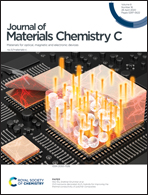Mixed-dimensional self-assembly organic–inorganic perovskite microcrystals for stable and efficient photodetectors†
Abstract
The instability of organic–inorganic perovskites in humid air is a serious bottleneck that restricts their practical applications in optoelectronics, although tremendous achievements have been made in organic–inorganic perovskite devices. Materials engineering is believed to be one of the most direct strategies to address this issue. Mixed-dimensional organic–inorganic perovskite microcrystals, which exhibit relatively good charge carrier transport owing to the limited grain boundaries and low defect densities compared to perovskite thin films, integrate the good humidity stability of two-dimensional (2D) and single-phase quasi-2D perovskites and the high photoresponse of 3D perovskites in an individual crystal, rendering them as excellent candidates for the development of high-performance photodetectors. Herein, the (C6H5CH2CH2NH3, PEA)2(CH3NH3, MA)n−1PbnBr3n+1 (n = 1, 3, 5, ∞) perovskite microcrystals were synthesized using an anti-solvent vapor-assisted method, and the optoelectronic properties of these microcrystals were investigated by fabricating photodetectors in a lateral configuration. The (PEA)2(MA)2Pb3Br10 and (PEA)2(MA)4Pb5Br16 perovskites proved to be mixed-dimensional microcrystals, respectively, which consist of the single phases of 2D (PEA)2PbBr4, quasi-2D perovskite, and 3D MAPbBr3. The photodetectors based on the individual (PEA)2(MA)2Pb3Br10 and (PEA)2(MA)4Pb5Br16 perovskite microcrystals perform better than the (PEA)2PbBr4 microcrystal photodetector and exhibit higher humidity resistance than the MAPbBr3 device. The best performances are achieved in the (PEA)2(MA)4Pb5Br16 microcrystal photodetector with a high responsivity of 182.63 A W−1, detectivity of 2.51 × 1014 Jones, and gain of 5.58 × 102, which can detect an optical signal with an extremely low light power density of 2.47 nW cm−2. Our results demonstrate that developing mixed-dimensional perovskite microcrystals is a promising way to construct highly efficient and stable photodetectors.



 Please wait while we load your content...
Please wait while we load your content...